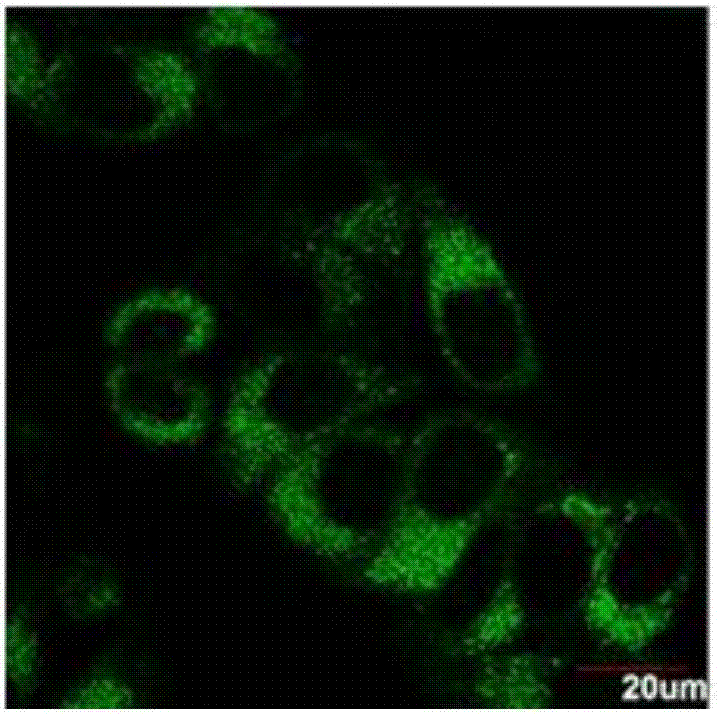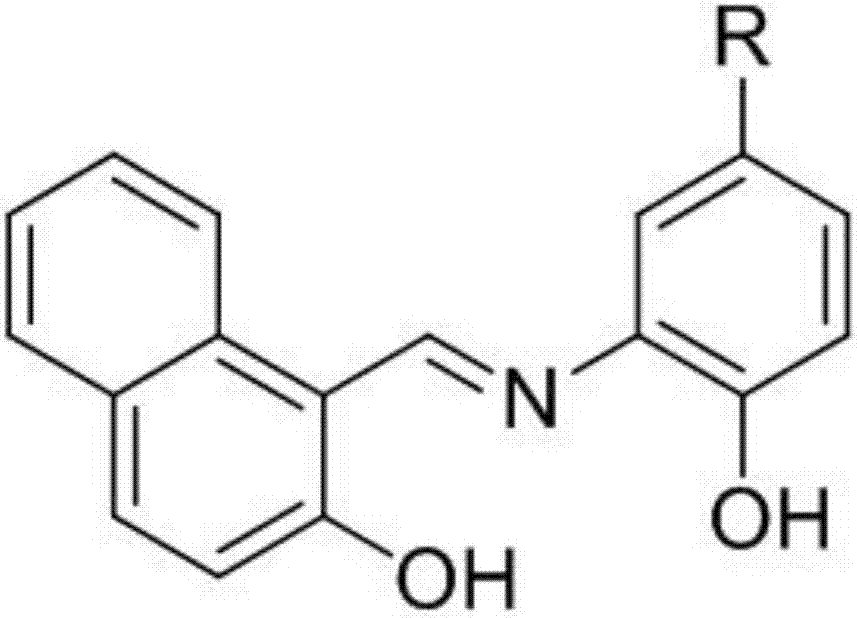Aluminium ion fluorescent probe
A technology of fluorescent probes and aluminum ions, applied in the field of fluorescent probes, can solve the problems of complex synthesis process and poor applicability, and achieve the effect of high sensitivity
- Summary
- Abstract
- Description
- Claims
- Application Information
AI Technical Summary
Problems solved by technology
Method used
Image
Examples
Embodiment 1
[0030] Example 1 Probe representative compound L 6 Synthesis and Characterization of (R=H)
[0031] Weigh 1.72g (10mmol) of 2-hydroxy-1-naphthaldehyde and 1.43g (10mmol) of 2-aminophenol, dissolve it in 35mL of absolute ethanol solution, remove water and heat to 70°C for 4 hours, and use TLC at any time during the reaction. Detection, after the reaction is finished, suction filtration while hot, the filtrate removes part of the solvent by rotary evaporation, separates out a brown solid, suction filtration, the filter cake is recrystallized with anhydrous methanol (ByHolzbecher, Zavis.Chemicke Listy pro Vedu a Prumysl.1953, 47, 680-688). Finally, 2.32 g of brown crystalline solid was obtained, and the yield was 80.55%. Melting point: 235.5-235.9°C. 1 H-NMR (400MHz, DMSO-d 6 ): δ (ppm) 15.71 (d, 1H, OH-Ar), 10.29 (s, 1H, HC=N), 9.51 (d, 1H, OH-Ar), 6.78-8.39 (m, 10H, H-Ar ).IR(KBr,cm -1 ):3119.0w, 3028.1w, 2555.8br, 1624.1s, 1585.7w, 1546.6s, 1513.0w, 1489.0w, 1461.0s, 140...
Embodiment 2
[0032] Example 2 Probe representative compound L 6 Sensitivity to aluminum
[0033] Using the synthesized probe compound L 6 Evaluate its sensitivity to aluminum ions. Probe representative compound L 6 Added to the sample pool containing 2mL of methanol, the final concentration of 4μM probe representative compound L 6 The methanol solution, and then respectively add the aqueous solution of aluminum chloride to this methanol solution successively, so that in the solution system made up of methanol and water, the concentration of aluminum chloride (i.e. trivalent chloride ion) is 0-100 μ M, excitation wavelength It is 450nm, and the maximum emission wavelength is at 528nm. The test results are shown in the table below, and the representative compound L of the probe is not added with aluminum chloride. 6 An intensity of 7.95 for the benchmark I min , the intensity detected every time after adding aluminum chloride is I, with I / I min to represent changes and contrasts in int...
Embodiment 3
[0038] Example 3 Probe representative compound L 6 The selectivity to aluminum
[0039] Representative compound L using synthetic probes 6 Evaluate its selectivity to aluminum ions. First prepare L at a concentration of 4 μM 6 stock solution (i.e. L 6 Methanol solution) and aqueous solutions of various common sodium salts, potassium salts, calcium salts, magnesium salts and other transition metal salts (metal hydrochlorides), the aqueous solution of the metal salt and the ligand L 6 After fully mixing and stabilizing for 40 min, the fluorescence intensity detection (excitation wavelength is 450nm and maximum emission wavelength is at 528nm) of the mixed solution is carried out sequentially, with pure L 6 The methanol solution carried the fluorescence corresponding to the intensity I 0 As a benchmark, with other ions and L 6 The strength of the mixed solution is I. The experimental results are shown in the table below: L 6 to Al 3+ The response is very obvious, and whe...
PUM
 Login to View More
Login to View More Abstract
Description
Claims
Application Information
 Login to View More
Login to View More - R&D
- Intellectual Property
- Life Sciences
- Materials
- Tech Scout
- Unparalleled Data Quality
- Higher Quality Content
- 60% Fewer Hallucinations
Browse by: Latest US Patents, China's latest patents, Technical Efficacy Thesaurus, Application Domain, Technology Topic, Popular Technical Reports.
© 2025 PatSnap. All rights reserved.Legal|Privacy policy|Modern Slavery Act Transparency Statement|Sitemap|About US| Contact US: help@patsnap.com



